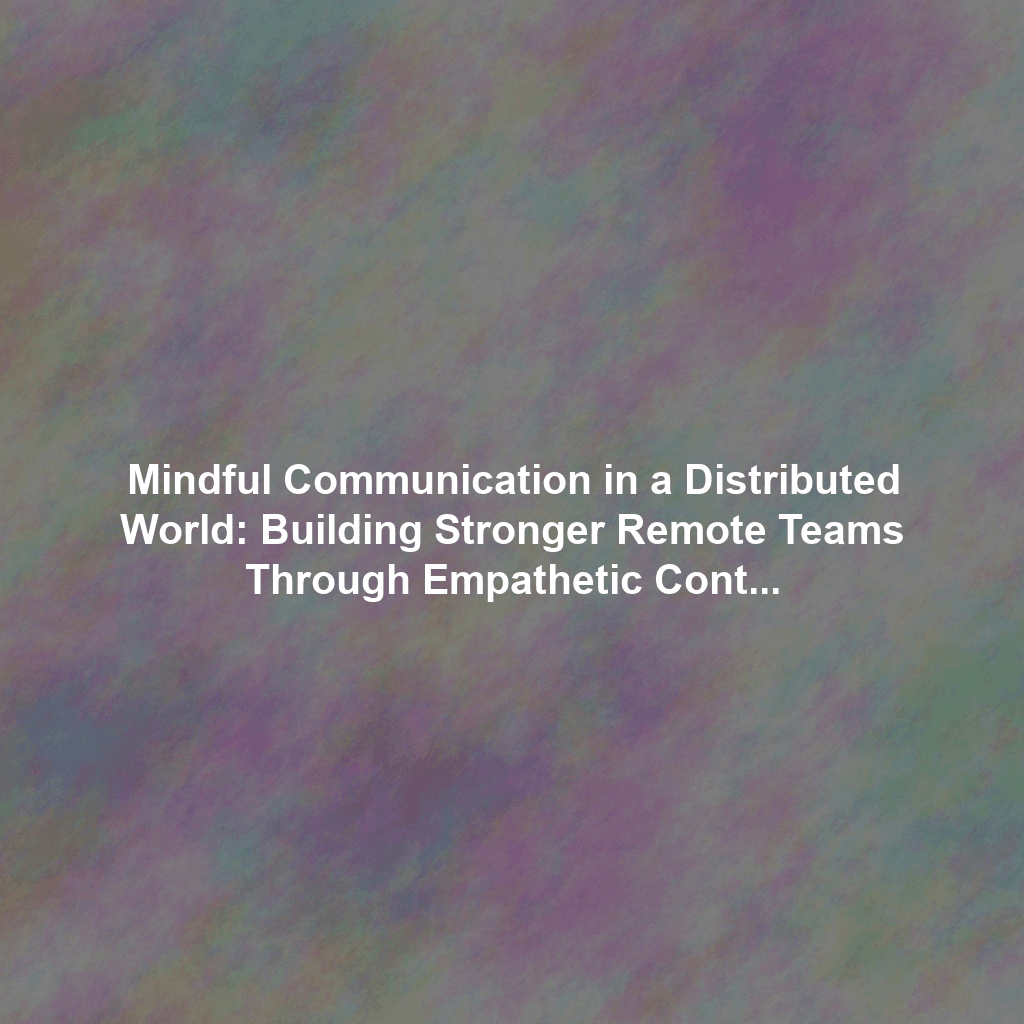The year is 2025. Remote work is no longer a trend; it’s the norm. But with dispersed teams comes the inherent challenge of maintaining strong connections and effective communication. We’re drowning in digital noise – endless emails, Slack channels overflowing with messages, and virtual meetings that seem to stretch into eternity. How can we cut through the chaos and cultivate meaningful interactions in this distributed landscape? The answer lies in mindful communication – a practice that emphasizes empathy, active listening, and clear expression, ultimately leading to stronger, more productive remote teams.
The Power of Mindfulness in Remote Communication
Mindfulness, the practice of paying attention to the present moment without judgment, offers a powerful antidote to the distractions and disconnections inherent in remote work. When applied to communication, it transforms how we interact, listen, and respond to our colleagues.
Reduced Stress and Increased Emotional Regulation
Remote work can be isolating and stressful. Mindful practices, such as meditation or deep breathing exercises, can help reduce anxiety and improve emotional regulation. This allows us to approach communication with a calmer, more focused mindset, preventing misunderstandings and promoting constructive dialogue.
Enhanced Empathy and Understanding
Mindfulness encourages us to step outside our own perspective and consider the feelings and experiences of others. This heightened empathy is crucial in remote teams, where nonverbal cues are often absent. By practicing mindful listening, we can better understand the unspoken needs and concerns of our colleagues, fostering stronger relationships and more collaborative workflows.
Improved Focus and Clarity
Distractions abound in the remote work environment. Mindfulness techniques can help us sharpen our focus and concentrate on the task at hand. This leads to clearer, more concise communication, reducing the risk of misinterpretations and ensuring that messages are received as intended.
Strategies for Empathetic Content Creation in Remote Teams
The content we create – whether it’s an email, a project update, or a presentation – plays a critical role in shaping the communication dynamic within a remote team. By focusing on empathy and clarity, we can create content that fosters connection and understanding.
Use Inclusive Language
Avoid jargon, acronyms, and cultural references that might exclude some members of the team. Use plain language that is easily understood by everyone, regardless of their background or technical expertise. Focus on “we” and “us” instead of “I” and “you” to promote a sense of shared purpose.
Provide Context and Rationale
In the absence of face-to-face interaction, it’s crucial to provide adequate context for your messages. Explain the rationale behind your decisions and clearly outline your expectations. This helps prevent misunderstandings and ensures that everyone is on the same page.
Embrace Visual Communication
Visual aids, such as charts, graphs, and images, can significantly enhance understanding and engagement. Use visuals to break up long blocks of text and to illustrate complex concepts. Consider incorporating video messages for a more personal touch.
Actively Seek Feedback
Don’t assume that your message has been received as intended. Actively solicit feedback from your colleagues to ensure that they understand your message and that their concerns are addressed. This demonstrates your commitment to effective communication and fosters a culture of open dialogue.
Mastering Asynchronous Communication in 2025
Asynchronous communication – communication that doesn’t require immediate responses – is the cornerstone of successful remote teams. It allows individuals to work at their own pace, respecting different time zones and work styles. However, it also requires careful planning and execution to avoid delays and misunderstandings.
Establish Clear Communication Protocols
Define which communication channels are appropriate for different types of messages. For example, urgent matters might warrant a direct message, while less time-sensitive updates can be shared via email or a project management platform. Establish response time expectations to avoid unnecessary delays.
Document Everything
Create a comprehensive knowledge base that documents important information, such as project goals, processes, and decisions. This ensures that everyone has access to the information they need, even if they’re working in different time zones. Tools like wikis and shared document repositories are invaluable in this regard.
Use Project Management Tools Effectively
Leverage project management tools to track progress, assign tasks, and communicate updates. These tools provide a centralized platform for collaboration, ensuring that everyone is aware of their responsibilities and deadlines. Utilize features like task descriptions, comments, and attachments to provide context and clarity.
Regularly Review and Refine Communication Strategies
The remote work landscape is constantly evolving. Regularly review your communication strategies to identify areas for improvement. Solicit feedback from your team members and be willing to adapt your approach to meet their needs. This ensures that your communication remains effective and efficient over time.
Building Stronger Relationships Through Mindful Communication
Ultimately, mindful communication is about building stronger relationships within your remote team. By practicing empathy, active listening, and clear expression, you can create a culture of trust, collaboration, and mutual respect. This not only leads to more productive workflows but also fosters a sense of belonging and connection, which is essential for the well-being of remote workers.
In 2025, mindful communication is no longer a nice-to-have; it’s a necessity for thriving in the distributed work environment. Embrace these strategies and cultivate a mindful approach to communication, and you’ll unlock the full potential of your remote team.
 Skip to content
Skip to content

